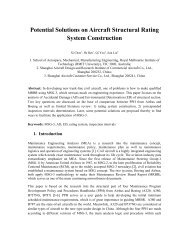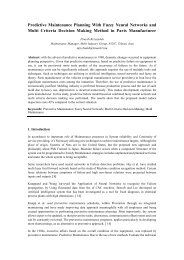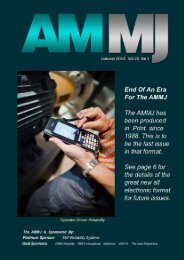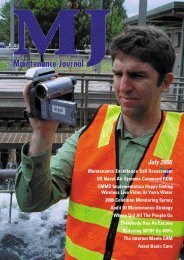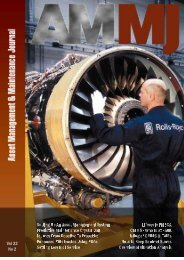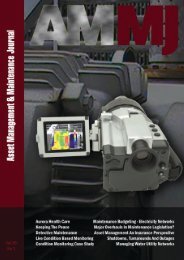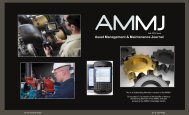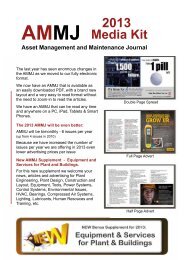July - AMMJ
July - AMMJ
July - AMMJ
You also want an ePaper? Increase the reach of your titles
YUMPU automatically turns print PDFs into web optimized ePapers that Google loves.
<strong>AMMJ</strong><br />
45<br />
[8] M. Matsumoto, Y. Shirai, I. Nakamura and N. Shiraishi [1989], ‘A Proposal of effective Thickness Estimation<br />
Method of Corroded Steel Member’, Bridge Foundation Engineering, Vol. 23, No. 12, pp 19-25. (In Japanese)<br />
[9] R. Rahgozar [2009], ‘Remaining Capacity Assessment of Corrosion Damaged Beams using Minimum Curves’,<br />
Journal of Constructional Steel Research, Vol. 65, pp 299-307.<br />
[10] S.M. Zahrai [2003], ‘Cyclic Strength and Ductility of Rusted Steel Members’, Asian Journal of Civil Engineering,<br />
Vol. 4, Nos. 2-4, pp 135-148.<br />
[11] T. Kaita, K. Tagaya, K. Fuji, M. Miyashita and M. Uenoya [2005], ‘A simple estimation method of bending<br />
strength for corroded plate girder’, Proceedings of the 3rd International Structural Engineering and Construction<br />
Conference (ISEC-03), Japan, pp 89-97.<br />
Spares Criticality Has Many Dimensions<br />
Phillip Slater Materials and Spare Parts Management Specialist (Australia)<br />
One of the things that most maintenance and reliability groups struggle with is the issue of spare parts criticality.<br />
It seems that criticality is often seen as a single dimension issue, that is, an item either is, or isn’t, critical. But<br />
I don’t think that is right. I think spare parts criticality is a multi-dimensional issue.<br />
What do I mean by multi-dimensional? Not that criticality exists in some science fiction space-time continuum<br />
but rather that it has a number of characteristics that need to be considered before deciding what to hold in<br />
inventory.<br />
For example, is the item in question machine critical or operationally critical? By machine critical I mean, will<br />
failure of the item stop the piece of equipment of which it is a part? By operationally critical, I mean, will failure<br />
of the item stop production? These two characteristics are quiet different and have a different impact on what<br />
to do next.<br />
For example, the globe in a headlight on my car is machine critical to the light. Obviously, the light will not work<br />
without the globe. But my car will still operate. In fact, in daylight hours there is no noticeable difference. If<br />
the globe fails at night I would notice the difference but would still be able to operate the car until I can get the<br />
globe replaced. Yes, safety will be slightly reduced but I think that this is, in this specific case, acceptable for<br />
a short period.<br />
Compare the globe failure with a fan belt failure. If you break a fan belt you won’t be able to drive for more<br />
than a few minutes before the vehicle starts to overheat and be un-drivable. The fan belt is not only machine<br />
critical it is also operationally critical. Yet, how many people carry spare fan belts for their cars? Not many.<br />
Why: because the failure is rare and the result may be inconvenient but in most cases tolerable (catch a taxi,<br />
get the car towed, call the auto club etc.). If you live in a city you are unlikely to carry a fan belt. If you live in<br />
or are driving through a remote area you probably would carry a fan belt. The decision (and quantity to hold)<br />
is dependent upon the situation.<br />
What about brakes. Everyone would agree that brakes are pretty important but who carries spare brake pads?<br />
No-one. Why: because inspections will identify pad wear so that you replace the pads before they become<br />
dangerous (plus the occasional grinding noise is a bit of a giveaway!) Everyone would argue that brake pads<br />
are operationally critical, but no-one would carry brake pads.<br />
Here we have three items. Each is machine critical, two are operationally critical, yet none are carried as spares,<br />
except in specific (for most of us unusual) circumstance. Spare parts criticality is definitely multi-dimensional<br />
and the inventory that we hold should be a function of the situation. For some critical spare parts we can still<br />
operate until we get the spare, for some we can wait until the spare arrives, for some we can manage through<br />
condition monitoring.<br />
Of course there are some items that we just can’t live without. Just don’t think that all items identified as critical<br />
will fall into that final category.<br />
Phillip Slater is a leading authority on materials and spare parts management and is currently celebrating ten<br />
years as an independent consultant, where he has assisted 297 companies, with more than 1,000 storerooms,<br />
holding $3.5bn in inventory. He is also the author of four operations management books, including Smart<br />
Inventory Solutions, now in its second edition and a recent finalist in the RGVA 2011 book awards. For more<br />
information on spare parts management visit Phillip’s website www.PhillipSlater.com.<br />
Vol 24 No 3




